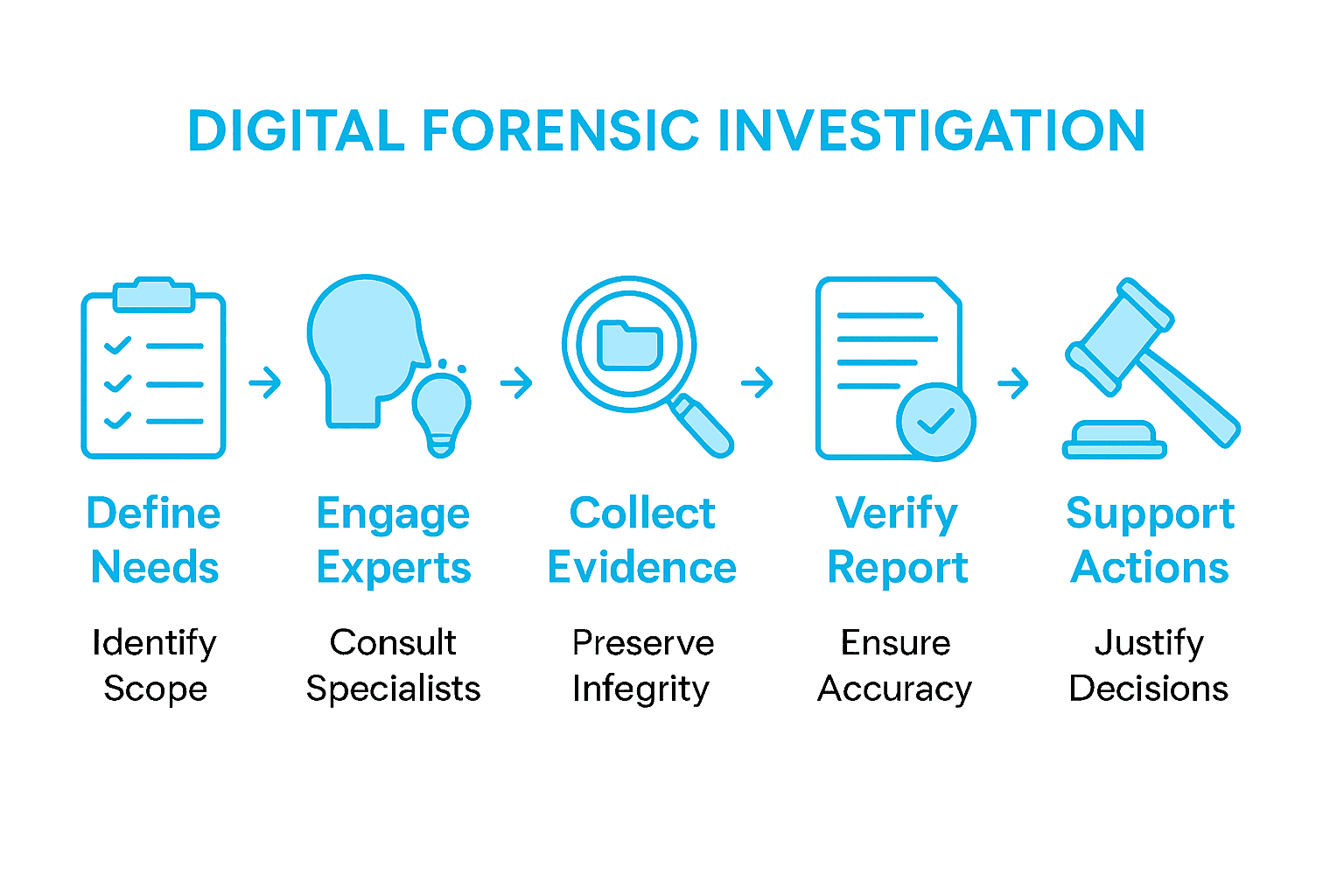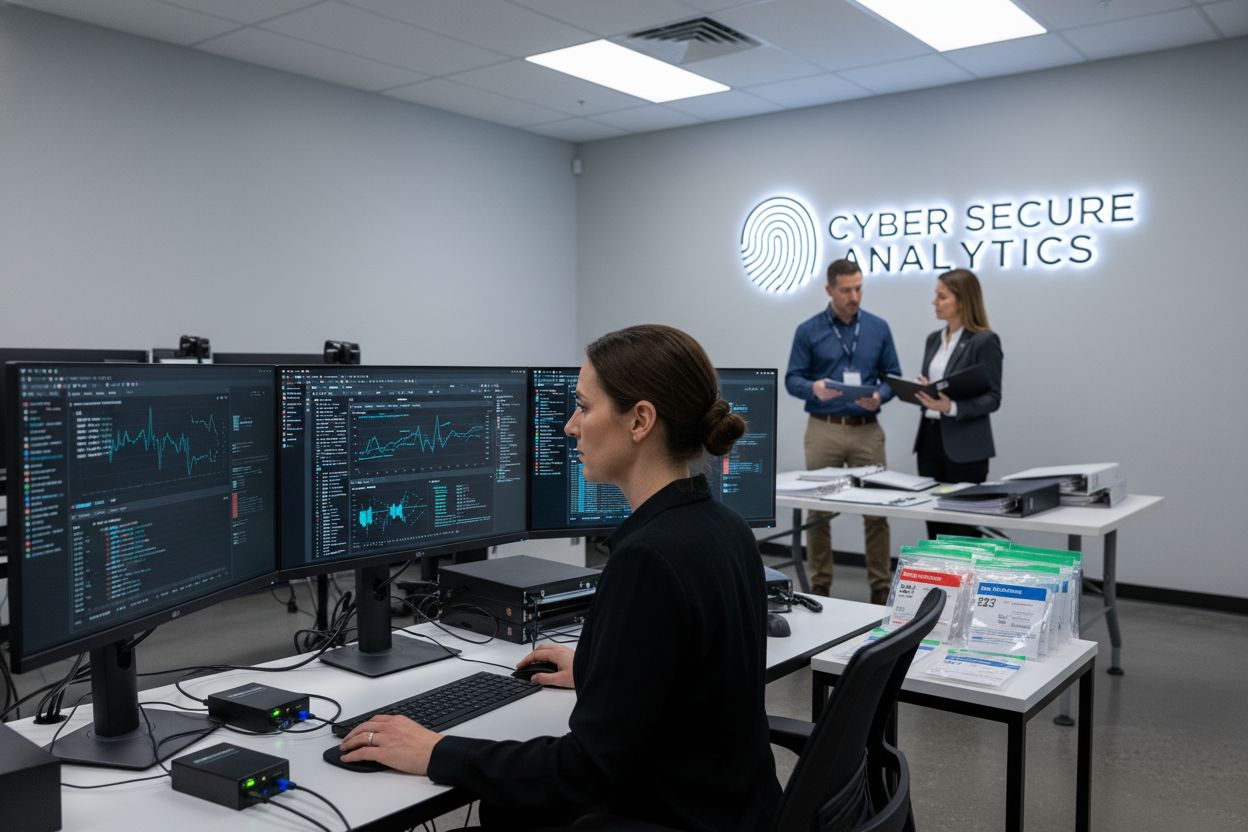Nearly 60 percent of businesses will face a digital incident this year, yet most feel unprepared when evidence becomes critical. When questions arise about insider threats, data breaches, or compliance issues, a well-structured forensic investigation is often the only path to clear answers. Following an expert process not only protects valuable data but can also make the difference between costly missteps and a successful outcome when legal or organisational stakes are high.
Quick Summary
| Key Point | Explanation |
|---|---|
| 1. Clearly Define Investigation Needs | Specify the type of incident and required digital evidence early to guide the investigation process effectively. |
| 2. Engage Professional Forensic Experts | Utilize skilled specialists to ensure evidence is handled correctly and adheres to legal standards. |
| 3. Collect Evidence Meticulously | Follow strict protocols to maintain the integrity of digital evidence during collection and preservation. |
| 4. Analyze Data with Sophisticated Techniques | Employ advanced methods to uncover hidden insights from digital evidence, ensuring thorough analysis. |
| 5. Prepare Comprehensive Expert Reports | Document findings rigorously to create a clear and legally defensible report for potential legal actions. |
Table of Contents
- Step 1: Assess Your Digital Investigation Needs
- Step 2: Engage Professional Forensic Expertise
- Step 3: Collect And Preserve Relevant Digital Evidence
- Step 4: Analyze Data Using Advanced Forensic Techniques
- Step 5: Verify Findings And Prepare Expert Reports
- Step 6: Support Litigation Or Internal Decision Making
Step 1: Assess Your Digital Investigation Needs
Before diving into a digital forensic investigation, you need a clear roadmap. This step helps you define precisely what digital evidence you require and understand the scope of your investigation.
Start by gathering comprehensive information about your specific situation. Are you investigating potential employee misconduct? Tracking intellectual property theft? Responding to a suspected data breach? Each scenario demands a targeted approach.
According to the Scientific Working Group on Digital Evidence (SWGDE), proper preparation hinges on clear communication about the investigation’s scope, legal authority, and potential technical challenges. This means identifying exactly what digital devices or platforms might contain relevant evidence digital phones, computers, cloud storage, social media accounts.
Your initial assessment should include:
- The specific incident or concern prompting the investigation
- Potential devices or digital platforms involved
- The types of digital evidence you anticipate needing
- Any known technical barriers like encryption or potential data destruction
Pro Tip: Document everything meticulously. Your initial assessment will guide the entire forensic investigation process.
Research from digital forensic workflow studies emphasises that clearly defining investigation needs helps forensic labs manage resources efficiently and reduce potential investigative backlogs. By being precise now, you save significant time and effort later.

In the next step, you will translate this assessment into a formal investigation strategy that guides digital evidence collection. 7 Essential Digital Forensic Techniques for Success can provide additional insights into developing a robust investigative approach.
Step 2: Engage Professional Forensic Expertise
After thoroughly assessing your digital investigation needs, the next critical step is bringing in specialised forensic expertise. This stage transforms your initial assessment into a precise, legally defensible investigation strategy.
Professional forensic experts offer skills and technologies far beyond standard IT support. They understand the intricate legal requirements for preserving digital evidence and can navigate complex technical challenges that might compromise your investigation.
According to best practices in cybersecurity forensics, engaging professionals becomes crucial when evidence integrity and admissibility are at stake. As research from digital forensics experts highlights, while non specialists might assist in early investigation stages, maintaining evidence chain of custody requires specialised skills.
When selecting a forensic specialist, consider these key factors:
- Professional certifications and relevant industry experience
- Proven track record in similar investigation types
- Understanding of legal evidence preservation standards
- Access to advanced forensic analysis tools and techniques
- Ability to provide expert witness testimony if required
Important Caution: Never attempt to investigate complex digital evidence without professional guidance. Improper handling can permanently destroy critical information.
Research from cybersecurity implementation studies emphasises developing clear forensic readiness plans that outline exactly when and how professional specialists should be engaged. This approach ensures systematic and legally robust digital investigations.
To understand more about what to expect during this process, our guide on understanding forensic computer expertise provides comprehensive insights into the professional investigative approach.
In the next step, you will work closely with your chosen forensic specialist to outline the specific investigation protocol and evidence collection strategy.
Step 3: Collect and Preserve Relevant Digital Evidence
With your forensic specialist engaged, you are now entering the most critical phase of your digital investigation: collecting and preserving digital evidence with meticulous precision. This step requires careful handling to ensure the integrity and admissibility of potential evidence.
According to the Scientific Working Group on Digital Evidence (SWGDE), collecting digital evidence involves specialized procedures that go far beyond simply copying files. Forensic professionals use sophisticated techniques to capture data without altering or contaminating the original digital artifacts.
The collection process typically involves several key strategies:
- Using write blockers to prevent accidental data modification
- Creating forensically sound bit by bit images of storage devices
- Generating cryptographic hash values to verify evidence integrity
- Documenting every step of the evidence acquisition process
- Securing both physical devices and digital storage environments
Recent guidance from digital forensics experts emphasises the importance of tracking every individual who handles evidence. Each interaction must be precisely documented to maintain what legal professionals call the “chain of custody”.
Pro Tip: Never attempt to collect digital evidence yourself. One wrong click can permanently alter or destroy critical information.
Professional forensic specialists will use certified tools and methodologies that meet strict legal and technical standards. They understand how to extract data from various devices without compromising its potential use in legal proceedings.
For more comprehensive insights into this critical process, our guide on essential digital evidence preservation methods offers an in depth exploration of forensic collection techniques.
In the next step, you will work with your forensic specialist to begin detailed analysis of the collected digital evidence.
Step 4: Analyze Data Using Advanced Forensic Techniques
With digital evidence collected, your forensic specialist now enters the most intellectually demanding phase: extracting meaningful insights through sophisticated analysis techniques. This step transforms raw data into actionable intelligence that can withstand legal scrutiny.
Forensic experts employ an array of advanced tools and methodologies far beyond simple file recovery. According to digital forensics experts, specialized software like EnCase and FTK allow professionals to reconstruct digital activity with extraordinary precision, uncovering hidden or deleted information that might seem permanently lost.
The analysis process involves multiple sophisticated techniques:
- Recovering deleted files and hidden system data
- Examining detailed metadata and file attributes
- Constructing comprehensive digital timelines
- Identifying patterns of user activity
- Detecting potential unauthorized access or data manipulation
A particularly fascinating modern approach is stochastic forensics. As research indicates, this technique can reconstruct digital activity by analyzing statistical patterns when traditional evidence artifacts are absent. It becomes especially powerful in complex scenarios like insider data theft investigations.
Pro Tip: Advanced forensic analysis is not about finding what is visible but uncovering what someone attempted to conceal.
Professional forensic specialists understand how to navigate complex digital landscapes. They can interpret seemingly random data points into coherent narratives that reveal the complete story behind digital interactions.
To gain deeper understanding of these intricate processes, our guide on forensic data analysis provides comprehensive insights into the sophisticated world of digital investigation techniques.
In the next step, you will review the forensic analysis findings and prepare for potential legal or organisational actions based on the discovered evidence.
Step 5: Verify Findings and Prepare Expert Reports
With complex digital forensic analysis complete, your specialist now enters the critical phase of verification and documentation. This stage transforms raw investigative findings into a legally defensible and professionally credible expert report.
According to the Scientific Working Group on Digital Evidence, preparing an expert report requires meticulous documentation that goes far beyond simply presenting findings. Every aspect of the investigation must be thoroughly documented and validated to ensure legal admissibility.
The verification and reporting process involves several key components:
- Cross referencing all digital evidence against original collection procedures
- Confirming forensic tool integrity and version documentation
- Generating comprehensive audit trails of all investigative steps
- Performing quality assurance checks on analysis techniques
- Ensuring compliance with legal and professional standards
Professional standards demand rigorous validation of each investigative technique. This means using standardized operating procedures and certified forensic tools that can withstand intense legal scrutiny.
Pro Tip: An expert report is not just about what you found but how precisely and professionally you found it.
The forensic specialist will compile a detailed report that includes technical findings, methodology explanations, and critical evidence summaries. This document must be clear enough for legal professionals to understand while maintaining scientific accuracy.
To understand the nuanced world of expert witness reporting, our guide on computer forensics expert witness services provides comprehensive insights into preparing courtroom ready documentation.
In the final step, you will review the expert report and discuss potential legal or organisational next steps based on the forensic investigation findings.
Step 6: Support Litigation or Internal Decision Making
With a comprehensive forensic report in hand, you are now prepared to leverage digital evidence for legal proceedings or organisational actions. This final stage transforms investigative findings into strategic insights that can drive critical decisions.
According to cybersecurity best practices, forensic specialists play a crucial role in bridging technical investigations with legal and organisational requirements. Their expertise extends beyond data collection into providing authoritative support for complex decision making processes.
Supporting litigation or internal actions involves several strategic elements:
- Presenting evidence in a clear and legally admissible format
- Collaborating with legal teams to interpret technical findings
- Preparing expert witness testimony if court proceedings are required
- Providing comprehensive context for digital evidence
- Recommending potential legal or organisational responses
Research from digital forensics standards emphasises the importance of securing evidence integrity throughout this process. Every piece of documentation must meet rigorous jurisdictional and regulatory standards to remain persuasive and actionable.
Pro Tip: The goal is not just to present evidence but to tell a compelling and credible digital narrative.
Forensic specialists work closely with legal professionals to translate technical findings into understandable arguments. They can explain complex digital interactions in ways that judges lawyers and organisational leaders can comprehend.
To gain deeper insights into the expert witness process, our guide on computer forensics expert witness services offers comprehensive information about effectively presenting digital evidence in legal contexts.
This concludes the comprehensive digital forensic investigation process preparing you to make informed legal or organisational decisions based on robust digital evidence.

Here’s a summary of each core step in the digital forensic investigation process:
| Step | Main Objective | Key Activities |
|---|---|---|
| Assess Needs | Define scope & evidence requirements | Identify incident Target devices Anticipate challenges |
| Engage Experts | Acquire specialised forensic support | Select professionals Review credentials Clarify responsibilities |
| Collect & Preserve Evidence | Secure evidence integrity | Use write blockers Image devices Document chain of custody |
| Analyse Data | Extract actionable insights | Recover data Build timelines Detect anomalies |
| Verify & Report | Document findings for legal use | Audit process Cross-reference data Prepare expert report |
| Support Actions | Enable legal or organisational decisions | Present evidence Provide context Assist in court |
Ready for Real Results from Digital Forensics?
Tackling digital investigations alone can put crucial evidence at risk. Whether you face employee misconduct, data breaches or cybercrime, your priorities are safeguarding evidence, maintaining chain of custody and ensuring expert analysis. As explored in this guide, even one error in evidence collection or reporting can impact your case.
If you need trusted support in unraveling suspicious activity or securing legal proof, rely on the specialists at Computer Forensics Lab. Our proven expertise spans comprehensive hacking investigation services, robust data recovery and impressive expert witness reporting designed for legal scrutiny. Take the next step with a digital forensic partner that understands your problems and delivers clear solutions. Get in touch today and gain peace of mind knowing your investigation is in expert hands.
Frequently Asked Questions
How can an IT forensic specialist assist with data breach incidents?
An IT forensic specialist can help investigate data breaches by identifying how the breach occurred and what information may have been compromised. Engage them immediately to collect and preserve digital evidence, which can be crucial for legal actions or internal review.
What steps do I need to take before contacting an IT forensic specialist?
Before reaching out to an IT forensic specialist, clearly define the scope of your investigation and the specific concerns, such as employee misconduct or intellectual property theft. Document the incident details and any relevant devices, as this information will guide the specialist in planning an effective approach.
How does the evidence collection process work during a digital investigation?
The evidence collection process involves using specialized tools to preserve the integrity of the digital data without altering the original artifacts. Ensure that you allow a forensic specialist to handle the collection to maintain the chain of custody, which is critical for legal admissibility.
What kind of reports can I expect from an IT forensic specialist after the analysis?
After analysis, you can expect a comprehensive report detailing the findings, the methodology used, and any significant evidence uncovered. This report should be organized in a way that clearly outlines technical details while remaining accessible for legal discussions or organizational decision-making.
How can an IT forensic specialist support me during court proceedings?
An IT forensic specialist can provide expert witness testimony in court, explaining the technical aspects of the evidence collected and its relevance to the case. Prepare to collaborate closely with them to craft a compelling narrative that effectively communicates the findings to the judge and jury.
How do I determine if I need an IT forensic specialist for my situation?
If your organization faces a cyber incident, such as a data breach or suspected insider threat, it’s crucial to consult an IT forensic specialist. Take prompt action to assess the situation and determine whether the complexity requires professional intervention to ensure proper evidence management.
